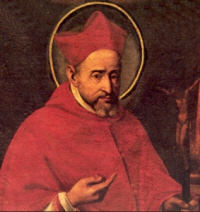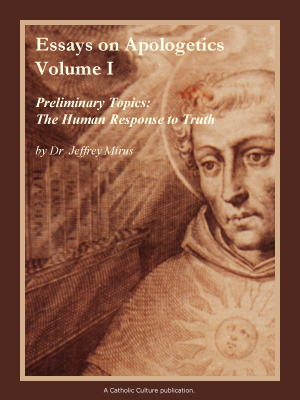Ordinary Time: September 17th
Thursday of the Twenty-Fourth Week of Ordinary Time; Optional Memorial of St. Robert Bellarmine, bishop and doctor
Other Commemorations: Impression of the Stigmata of St. Francis
» Enjoy our Liturgical Seasons series of e-books!
St. Robert Bellarmine (1542-1621) was born in Montepulciano, Italy, and died in Rome. The son of noble parents, he entered the Society of Jesus, finishing his theological studies at Louvain, Belgium. His services to the Church were outstanding and many. He occupied the chair of controversial theology in Rome. He defended the Holy See against anti-clericals. He wrote books against the prevailing heresies of the day. His catechism, translated into many languages, spread the knowledge of Christian doctrine to all parts of the world. He was the Counsellor of Popes and spiritual director of St. Aloysius Gonzaga. He helped St. Francis de Sales obtain approval of the Visitation Order. As a religious he was a model of purity, humility and obedience; as a bishop and Cardinal, an example of great love for his flock.
According to the 1962 Missal of St. John XXIII the Extraordinary Form of the Roman Rite, today is the feast of the Commemoratioin of the Imprinting of the Holy Stigmata on the Body of St. Francis and St. Robert Bellarmine's feast is celebrated on May 13. Two years before his death St. Francis retired to Mt. Alverno where he began a forty days' fast in honor of St. Michael the Archangel. There, while in a state of continual prayer and unceasing watching, he saw in a vision a seraph with burning, dazzling wings whose feet and hands were nailed to a cross; at the same time five wounds, like those of our Lord, appeared on Francis' feet, hands and side; from the wound in his side blood flowed. These stigmata were so fully verified subsequently that the Franciscans since the fourteenth century have celebrated a feast in honor of the event.
St. Robert Bellarmine
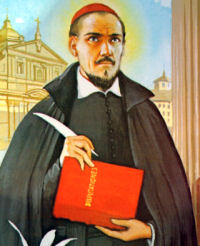 He was born at Montepulciano in Tuscany on October 4, 1542, the feast of the Poverello of Assisi toward whom he always cherished a special devotion. The day on which he died, September 17, is now the feast in honor of the stigmata of St. Francis.
He was born at Montepulciano in Tuscany on October 4, 1542, the feast of the Poverello of Assisi toward whom he always cherished a special devotion. The day on which he died, September 17, is now the feast in honor of the stigmata of St. Francis.
In 1560 Robert Bellarmine entered the Society of Jesus. He easily ranks among its greatest men, illustrious for learning as well as for piety, humility, and simplicity of heart. If it were possible to summarize his life in a single sentence, one that would resolve all the varied activities and accomplishments of his long career, a verse from the psalm might serve: "If I forget you, Jerusalem, may my right hand be forgotten." His most important work was controversial in nature but the impact of his presentation "resembled the final chord in a mighty cantata, a chord that resounded through all the vice and scandal resulting from the internal corruption of the Church of that day, and that chord heralded Mother Church as one, holy, and Catholic" (E. Birminghaus).
Bellarmine also acted as confessor to the youthful Aloysius and John Berchmans. It might be asked why three hundred years passed before the beatification and canonization of Bellarmine. Long ago Bishop Hefele pointed to the reason when he wrote: "Bellarmine deserves the highest degree of respect from Catholics, even though he has not been canonized. Those who labored to besmirch him have only erected a monument of shame for themselves!" Finally in 1923, he was beatified; canonization followed in 1930, and on September 17, 1931, Pope Pius XI declared him a doctor of the Church.
—Excerpted from The Church's Year of Grace, Pius Parsch
Patronage: canon lawyers; canonists; catechists; catechumens; archdiocese of Cincinnati, Ohio; archdiocese of Capua, Italy
Symbols and Representation: red hat of a cardinal; book denoting doctor of the Church; pictured in the red garments of a Cardinal
Highlights and Things to Do:
- Study the connections between Saints Robert Bellarmine, Aloysius Gonzaga, and Francis de Sales.
- Learn more about the different versions of the Bible.
- Learn more about the Code of Canon Law and what canon lawyers do, compared to regular lawyers.
- Read the Congregation for the Doctrine of the Faith's document, Doctrinal Note on Some Questions Regarding the Participation of Catholics in Political Life.
- Read The Seven Words Spoken on the Cross and The Art of Dying Well by St. Robert Bellarmine online.
- Read more about St. Robert Bellarmine:
- You can also read The Art of Dying Well online here.
- Watch this short excerpt of this video, beginning minute 8:55, ending 14:33, on the lasting impact of St. Robert Bellarmine.
St. Hildegarde
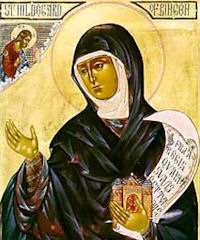 Called the "Sibyl of the Rhine," Hildegard of Bingen became the most famous mystic and prophet of her time. Her writings and music are still found in all major bookstores, and no woman saint is more popular in her native Germany. When she was eight, she was placed in a convent, where she later became abbess. She was a biblical exegete, visionary, preacher, composer, and herbalist, who corresponded with the major royalty and church leaders of her day, including four popes. Her greatest vision came when she was forty-two, which is recorded in her famous Scrivias, or Know the Ways of the Lord, a treatise whose magnificence rivals William Blake's visionary work. Hildegard's spiritual writings found approval during her lifetime, and her lectures on the spiritual life drew crowds from all over Europe. She wrote prolifically, on topics as varied as history and drama, polictics and and liturgical poetry. Her monastery joyfully sang the praises she wrote. During the last year of her life, when she was eighty-one, she entered into a conflict with ecclesiastical authorities because she allowed a young man who had been excommunicated to be buried in her abbey cemetery, and her convent was placed under interdict. It is probably that, for this reason, Hildegard was never formally canonized, although she is found in all major saints' books and her cult was approved locally because of so many miracles reported at her tomb.
Called the "Sibyl of the Rhine," Hildegard of Bingen became the most famous mystic and prophet of her time. Her writings and music are still found in all major bookstores, and no woman saint is more popular in her native Germany. When she was eight, she was placed in a convent, where she later became abbess. She was a biblical exegete, visionary, preacher, composer, and herbalist, who corresponded with the major royalty and church leaders of her day, including four popes. Her greatest vision came when she was forty-two, which is recorded in her famous Scrivias, or Know the Ways of the Lord, a treatise whose magnificence rivals William Blake's visionary work. Hildegard's spiritual writings found approval during her lifetime, and her lectures on the spiritual life drew crowds from all over Europe. She wrote prolifically, on topics as varied as history and drama, polictics and and liturgical poetry. Her monastery joyfully sang the praises she wrote. During the last year of her life, when she was eighty-one, she entered into a conflict with ecclesiastical authorities because she allowed a young man who had been excommunicated to be buried in her abbey cemetery, and her convent was placed under interdict. It is probably that, for this reason, Hildegard was never formally canonized, although she is found in all major saints' books and her cult was approved locally because of so many miracles reported at her tomb.
Hildegarde was declared a Doctor of the Church on October 7, 2012 by Pope Benedict XVI.
—Excerpted from Women Saints, Madonna Sophia Compton
Highlights and Things to Do:
- Listen to the Catholic Culture "Way of the Fathers" podcast episodes on St. Hildegard by Dr. James Papandrea:
- Listen to the Catholic Culture podcast with Thomas Mirus: 198—The Music of St. Hildegard of Bingen—Margot Fassler
- Read more about St. Hildegard:
- Visit Hildegard's Medieval Garden.
- St. Hildegard was a composer, visit this page to read more.
- Read St. Hildegard of Bingen: A Visionary for All Time.
- Watch this short video about St. Hildegard from Sheen Center for Thought and Culture.
Stigmata of St. Francis
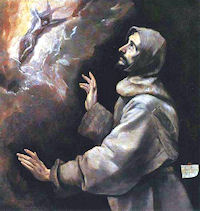 Saint Bonaventure, biographer of Saint Francis of Assisi, wrote that two years before his holy death he had been praying on Mount Alverno in a solitary retreat, where he had gone to fast for forty days in honor of the Archangel Michael. No one ever meditated more than Francis on the Passion of his Lord. During his retreat he beheld in vision a six-winged Seraph attached to a cross, and received at the same time a painful wound of the heart, which seemed to transpierce it. When the vision ended his own hands and feet bore the marks of the angelic crucifixion which he had seen in the vision. He understood by his vision that the soul must come to resemble Christ by the ardors of its interior fire, rather than by any physical, exterior means. We reproduce here a meditation of the saintly 19th century Abbot, Dom Guéranger of Solemnes in France.
Saint Bonaventure, biographer of Saint Francis of Assisi, wrote that two years before his holy death he had been praying on Mount Alverno in a solitary retreat, where he had gone to fast for forty days in honor of the Archangel Michael. No one ever meditated more than Francis on the Passion of his Lord. During his retreat he beheld in vision a six-winged Seraph attached to a cross, and received at the same time a painful wound of the heart, which seemed to transpierce it. When the vision ended his own hands and feet bore the marks of the angelic crucifixion which he had seen in the vision. He understood by his vision that the soul must come to resemble Christ by the ardors of its interior fire, rather than by any physical, exterior means. We reproduce here a meditation of the saintly 19th century Abbot, Dom Guéranger of Solemnes in France.
The Feast of the Stigmata of Saint Francis, whom we will soon honor again on his feast of October 4th, is not only to glorify a Saint; it commemorates and signifies something which goes beyond the life of any single man, even one of the greatest of the Church. The God-Man never ceases to live on in His Church, and the reproduction of His own mysteries in this Spouse whom He wants to be similar to Himself, is the explanation of history.
In the thirteenth century it seemed that charity, whose divine precept many no longer heeded, concentrated in a few souls the fires which had once sufficed to inflame multitudes. Sanctity shone as brilliantly as ever, but the hour for the cooling of the brazier had struck for the peoples. The Church itself says so today in its liturgy, at the Collect: ‘Lord Jesus Christ, when the world was growing cold, You reproduced the sacred marks of Your passion in the body of the most blessed Francis, in order that Your love might also set our hearts afire.’ The Spouse of Christ had already begun to experience the long series of social defections among the nations, with their denials, treasons, derision, slaps, spittings in the very praetorium, all of which conclude in the legalized separation of society from its Author. The era of the Passion is advanced; the exaltation of the Holy Cross, which for centuries was triumphant in the eyes of the nations, acquires in the sight of heaven, as the Angels look down upon it, the aspect of an ever closer resemblance with the Spouse to the sufferings of her crucified Beloved.Saint Francis, loved today by all who know of him—and few there are who do not—was like precious marble placed before an expert sculptor. The Holy Spirit chose the flesh of the seraph of Assisi to express His divine thought, thus manifesting to the world the very specific direction He intends to give to souls thereafter. This stigmatization offers a first example, a complete image, of the new labor the divine Spirit is meditating—total union, on the very Cross of Christ itself, of the mystical Body with the divine Head. Francis is the one honored by this primacy of choice; but after him the sacred sign will be received by others, who also personify the Church. From this time on, the Stigmata of the Lord Jesus will be at all times visible, here and there on this earth.
—Excerpted from L’Année liturgique, by Dom Prosper Guéranger (Mame et Fils: Tours, 1919), “The Time after Pentecost V”, Vol. 14, translation O.D.M.
Highlights and Things to Do:
- Read this story about St. Francis and the Stigmata.
- Read more about the Stigmata of St. Francis here.
- Read Stigmata of St. Francis: 3 Ways for Holiness.
Autumn Embertide: Ember Wednesday
The Ember days of Autumn are days of thanksgiving for the completed harvest of fruits and grapes. The pre-1962 liturgy connects the Ember Days with the solemn commemoration of the Jewish New Year’s celebration of the Old Testament (Rosh Hashanah) and the great Day of Atonement (Yom Kippur). These Ember days, therefore, have become days of thanksgiving and atonement. There are four focal points for the September Embertide:
- Days of Thanksgiving. The Autumn Ember Days days of thanksgiving for the completed harvests of fruits and particularly grapes. The former liturgy connected the Ember Days with are outside the main liturgical seasons (Advent, Christmas, Lent and Easter) but are closest to the Fall Equinox. We are giving special thanks to God for the gifts of the fall harvest, particularly the grapes, which give us the gift of wine for the Eucharist.
- Days of Atonement, Spiritual Renewal and Refreshment. Holy Mother Church provides us with yet another opportunity to redirect, refresh and renew.
- Prayer for Priests. The Church no longer regularly ordains priests during the Quarterly Ember Days, but this is a special time, particularly Ember Saturday, to pray for priests and for seminarians, particularly the ones who are about to be ordained within the year.
- Reflecting on the Spirit of the Season.. Each set of Ember Days reflect the season of the Liturgical Year in which they occur. The Ember Days in September are outside the main liturgical seasons (Advent, Christmas, Lent and Easter) and are closest to the Fall Equinox in the Northern Hemisphere, when the days grow shorter and nights grow longer. September is harvesting time, and a time of preparation for winter. It is a busier time for most, and not just because of agrarian needs. September marks a time of transition with the beginning of the academic year.
Wednesday of Ember week was traditionally devoted to our Lady and in imitation of her it was a day of reflection and spiritual orientation. All four Ember Wednesdays were celebrated in the station church of St. Mary Major.
September Ember Wednesday Meditation
This excerpt from Pius Parsch is based on the 1962 Missal. The current Missal doesn't have special propers and readings for Ember Days.
Wednesday of Ember week is always “Mary’s Day”’ hence at Rome the divine liturgy is celebrated in the Basilica of St. Mary Major.
Hardly any other Ember Mass brings us as much of the spirit of the olden Ember festivals as this. The opening words put us immediately in a joyous mood. And at the climax of the celebration we proclaim with the Church, “The joy of the Lord is our true strength.” It is an idea worth remembering. Christian does not seek to lame the vital forces of life but to purify and ennoble them. Where there is life, there must be feeling, spirit, joy. One should not think that such expressions of life are questionable or proper only to the children of the world. Nor must joy confine itself to the supernatural, over the natural too we may be happy. Ember week provides a splendid occasion to show joyous gratitude for the gifts and fruits of nature.
Now a few observations on the three Lessons, for in striking graduation they bring to our attention three primary Ember blessings: bodily food—spiritual nourishment—fasting.
First Lesson, Amos 9:13-15. Amos, the shepherd-prophet, projects the prosperity of the Holy Land after the return from exile. He is, we know, describing in prophetical perspective the spiritual well-being of God’s kingdom upon earth and the blessedness of the “new heaven and the new earth” hereafter. The early Church, however, would adapt in adopting and used the text to score the produce of nature presently being harvested. We are being urged to show a most sincere gratitude to the Father and Source of whatever comes from field, orchard, or garden. Let nature be a big picture-book illustrating the good and great God on every page. It is the warmth of His love that is ripening autumn’s baskets of vegetables, grain, and fruit.
Second Lesson, 2 Esdras 8:1-10 or Nehemiah 8:1-10. Alongside these baskets of food for our bodies, the liturgy places supernatural nourishment, the word of God. For the Lord once said: “Not from bread alone does man live, but by every word that comes from the mouth of God.” On few occasions in history was the word of God more highly esteemed than that recorded in the second Lesson. Esdras read from the inspired scroll; with holy reverence the people listened before worshipping God present in His words, exultingly joyous over the divine revelation. These then are the two principal blessings of the past quarter-year, bread for the body and the word of God for the soul. They have come to us in abundance. And we are grateful.
Third Lesson, Mark 9:16-28. How does fasting fit into the picture? Human nature is subject to the curse of original sin; like the boy in the Gospel we come under the devil’s influence, and his power cannot be counteracted with the usual tools. Extraordinary tools are necessary, like “prayer and fasting.” A good reason, surely, for the quarterly Ember days. With thankful hearts we may enjoy the fruits of earth, praising the good God; the inspired words of holy Scripture may bring untold spiritual blessings; nevertheless, more is needed. to tame proud and stubborn nature the mighty levers of prayer and fasting must be brought into action, not merely our own individual praying and fasting, but that of Christ too, viz., the oblation of His whole life as it comes to us through Mass and holy Communion.
—Excerpted from Pius Parsch, Year of Grace, Volume 5
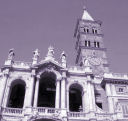
September Ember Wednesday
Station with Santa Maria Maggiore (St. Mary Major):
We humbly ask today's great patroness, Mary, the Mother of Jesus, to obtain for us a true ember spirit and to accompany us as we approach the holy Table "to eat fat meats, and drink sweet wine, and send portions to them that have not prepared for themselves; because it is the holy (ember) day of the Lord; be not sad, for the joy of the Lord is our strength." (Msgr. Martin Hellriegel)
For more on Santa Maria Maggiore, see:
For further information on the Station Churches, see The Stational Church.


